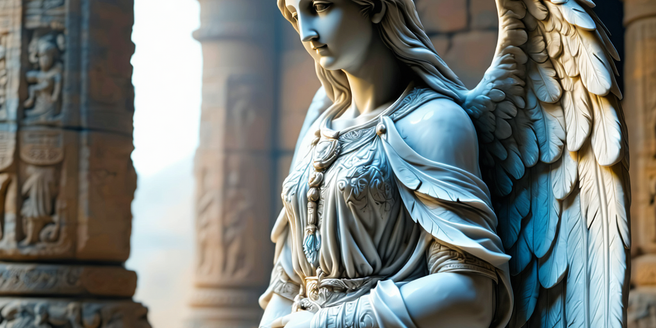Understanding the Concept of Angels
| Characteristics | Roles | Beliefs |
| Heavenly | Guidance | Christianity |
| Messengers | Protection | Islam |
| Invisible | Healing | Judaism |
| Pure | Assistance | Hinduism |
| Holy | Intervention | Buddhism |
| Winged | Communication | Sikhism |
Historical Accounts of Angelic Visits
Throughout history, many cultures and religions have documented incredible accounts of angelic visits, providing fascinating insights into these celestial encounters. One of the most notable examples can be found in the Bible, where angels are described as messengers of God, delivering news that profoundly impacts human lives. For instance, the angel Gabriel’s visit to the Virgin Mary in the New Testament heralded the birth of Jesus Christ, a pivotal moment in Christian theology. Similarly, in the Hebrew Bible, the story of Jacob’s ladder reveals heaven’s proximity to earth, as angels ascend and descend, symbolizing divine connection and guidance. Beyond the Judeo-Christian tradition, angelic figures appear in Islamic teachings as well, with angels playing various roles in delivering divine revelations to Prophet Muhammad, most significantly through the angel Jibril (Gabriel). These accounts, transcending different time periods and cultures, indicate a profound human fascination with the divine and mystical.
Modern-Day Angel Encounters
In today’s fast-paced world, the idea of encountering angels might seem reserved for ancient texts or mythological tales, yet modern-day angel encounters are more common than many realize, touching countless lives with their ethereal presence. Whether perceived in a fleeting glimpse of a glowing figure or an inexplicable sense of peace during dire times, these encounters instill a profound sense of awe and reverence. Often described as mysterious strangers who appear in critical moments, offering guidance and protection, angels today continue to symbolize hope and divine intervention. They transcend religious boundaries, appearing across various cultures and beliefs, reinforcing the universal longing for connection with something greater than ourselves. These encounters inspire introspection about our own lives, encouraging us to pay closer attention to signs from the universe and embrace the possibility of the extraordinary within the ordinary.
Miracles in Religious Texts
Miracles have always been a focal point within religious texts, transcending the ordinary to provide glimpses of the divine. These extraordinary events, described across various scriptures, serve as powerful demonstrations of faith intended to inspire and renew belief. Within the Christian tradition, miracles such as Jesus turning water into wine or walking on water are seen as embodiments of divine intervention that emphasize his authority and divinity. Similarly, in the Quran, the splitting of the moon attributed to Prophet Muhammad showcases the might and mystery of divine will. Hindu scriptures recount Lord Krishna’s breathtaking feats, reinforcing the dharma and his divine nature. Beyond their immediate wonder, these miraculous accounts invite followers to ponder deeper meanings, offering profound insights into spiritual and ethical teachings. Through miracles, the mundane is transformed, fostering a connection between humanity and the divine world.
Scientific Perspectives on Miracles
Throughout history, miracles have been revered as extraordinary events that defy natural explanation, often attributed to divine intervention. However, from a scientific perspective, miracles invite critical inquiry and skepticism. Scientists approach miracles with the tools of observation, hypothesis, and experimentation, seeking to understand if these events can be explained through natural laws. For instance, phenomena that were once deemed miraculous, such as eclipses or the healing properties of certain plants, are now well understood through scientific exploration. This perspective encourages the belief that some events described as miracles may simply be due to our current limitations in scientific knowledge rather than a suspension of natural laws. However, it’s crucial to acknowledge that science, by its very nature, is open-ended. While it strives to unravel mysteries and provide logical explanations, it also recognizes the vast unknown, leaving room for wonder and awe.
Personal Stories of Miraculous Events
In the realm of the extraordinary, personal stories of miraculous events often leave us in awe, offering a glimpse into the mysterious tapestry of life. These narratives, woven from the fabric of real-life experiences, carry a powerful reminder of the unexpected wonders that can touch our lives. Take, for instance, a story shared by Sarah, whose life changed in an instant when a stranger’s timely intervention saved her from a highway accident. Miraculously unscathed, she credits this chance encounter as a divine intervention. Stories like Sarah’s remind us of the invisible thread that connects us all; a testimony to unseen forces at play, guiding us toward hope and resilience. Whether it’s the sudden remission of a terminal illness or the unexplainable appearance of a long-lost loved one, these miraculous tales inspire us, reassuring us that even in our darkest moments, light can emerge unexpectedly.
The Role of Faith in Witnessing Miracles
Faith plays a pivotal role in witnessing miracles, often serving as the lens through which extraordinary events are perceived and understood. It acts as a catalyst that bridges the gap between the seen and unseen, the possible and the impossible. For many believers, faith is a deeply personal conviction that sustains hope and expectation for divine intervention. When an individual holds steadfast belief in a higher power, they become more attuned to recognizing moments of grace and wonder as miraculous. This openness not only amplifies the impact of the miracle but also reinforces the believer’s spiritual journey, affirming their trust in a benevolent force greater than themselves. In communities of faith, shared stories of miracles inspire collective belief, further nurturing an environment where such phenomena are accepted as tangible realities rather than mere coincidences. Thus, faith transforms the improbable into the tangible, making miracles a part of everyday life.
Angels Across Different Cultures
Angels hold a special place in the mythologies and religions of many cultures around the world, often embodying the bridge between the divine and the human. In Christianity, angels like Gabriel play crucial roles as messengers of God, delivering divine revelations. Similarly, in Islam, angels are revered as celestial beings created from light, with pivotal roles such as archangels Gabriel (Jibril) and Michael (Mikail) ensuring the execution of God’s will. Moving to Eastern philosophies, the concept of “Devas” in Hinduism and Buddhism reflects angel-like beings guarding cosmic order and bestowing blessings. Meanwhile, in Zoroastrianism, angels are seen as manifestations of divine attributes, such as Vohu Manah representing good mind and intentions. In addition, indigenous cultures across the world have their own interpretations of angelic beings, often seen as guiding ancestral spirits offering wisdom and protection, all echoing a universal human desire for connection with the sacred.
Skepticism and Belief: A Balanced View
In an increasingly complex world, navigating through skepticism and belief can be a tightrope walk. On the one hand, skepticism encourages us to question the status quo, to challenge conventional wisdom, and to critically evaluate the information before us. It acts as a shield against misinformation and dogmatism, fostering a culture of inquiry and innovation. On the other hand, belief offers a sense of grounding and purpose. It frames our perceptions with narratives that provide meaning and direction. A balanced view requires harmonizing these two forces — allowing skepticism to refine our beliefs while letting belief guide our inquiries with intention and optimism. In cultivating this balance, we embrace the uncertainty of life not as a burden, but as a canvas for growth. It’s a dance between doubt and certainty, where each step propels us toward greater understanding and empathy.
How to Recognize Miraculous Signs
Recognizing miraculous signs often requires a blend of mindfulness, openness, and intuition. To begin with, mindfulness is key; it’s about being present and attentive to the world around you. Spend time each day in quiet reflection, perhaps through meditation or journaling, to clear your mind of distractions. By doing so, you’ll be more in tune with subtle changes and remarkable occurrences that might otherwise go unnoticed.
Openness is also crucial. It involves being receptive to messages that may defy conventional explanations. To foster this mindset, cultivate a sense of curiosity and let go of rigid beliefs that limit your perception. Look beyond the ordinary and be willing to accept the extraordinary.
Finally, trust your intuition. Often, a miraculous sign will resonate deeply within you. If something feels significant or looks like a message, reflect on its personal meaning and potential for guidance in your life.










